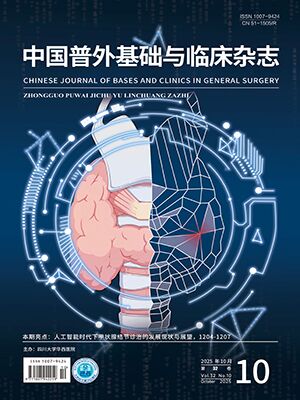| 1. |
Xu S, Qiu J, Zhang H, et al. Influences of Hiao’s double-C nursing model combined with pain care on postoperative satisfaction with pain control and complications in patients with mixed hemorrhoids. Am J Transl Res, 2021, 13(9): 10676-10684.
|
| 2. |
汪铁钢, 端传友, 吴国魁, 等. 齿线上方黏膜C形切除吻合术治疗Ⅳ度混合痔的疗效及术后复发情况分析. 中国普外基础与临床杂志, 2024, 31(6): 726-732.
|
| 3. |
中国中西医结合学会大肠肛门病专业委员会. 中国痔病诊疗指南 (2020). 结直肠肛门外科, 2020, 26(5): 519-533.
|
| 4. |
Cemil A, Ugur K, Salih GM, et al. Comparison of laser hemorrhoidoplasty and Milligan-Morgan hemorrhoidectomy techniques in the treatment of grade 2 and 3 hemorrhoidal disease. Am Surg, 2024, 90(4): 662-671.
|
| 5. |
汤慧丽, 郑德, 王奕韵, 等. 穴位埋线防治混合痔术后疼痛的临床疗效观察. 上海中医药大学学报, 2022, 36(4): 36-40, 51.
|
| 6. |
中华医学会麻醉学分会. 成人手术后疼痛处理专家共识. 临床麻醉学杂志, 2017, 33(9): 911-917.
|
| 7. |
中华医学会胸心血管外科学分会胸腔镜外科学组, 中国医师协会胸外科医师分会微创外科专家委员会. 中国胸外科围手术期疼痛管理专家共识 (2018版). 中国胸心血管外科临床杂志, 2018, 25(11): 921-928.
|
| 8. |
中华医学会外科学分会, 中华医学会麻醉学分会. 加速康复外科中国专家共识及路径管理指南 (2018版). 中国实用外科杂志, 2018, 38(1): 1-20.
|
| 9. |
全军麻醉与复苏学专业委员会, 中华医学会麻醉学分会, 陆军军医大学第一附属医院, 等. 战创伤疼痛管理专家共识. 麻醉安全与质控, 2020, 4(5): 256-261.
|
| 10. |
国家卫生健康委员会医管中心加速康复外科专家委员会, 浙江省医师协会临床药师专家委员会, 浙江省药学会医院药学专业委员会. 中国加速康复外科围手术期非甾体抗炎药临床应用专家共识. 中华普通外科杂志, 2019, 34(3): 283-288.
|
| 11. |
Albrecht E, Chin KJ. Advances in regional anaesthesia and acute pain management: a narrative review. Anaesthesia, 2020, 75 Suppl 1: e101-e110. doi: 10.1111/anae.14868.
|
| 12. |
Prabhakar A, Ward CT, Watson M, et al. Liposomal bupivacaine and novel local anesthetic formulations. Best Pract Res Clin Anaesthesiol, 2019, 33(4): 425-432.
|
| 13. |
Ilfeld BM, Eisenach JC, Gabriel RA. Clinical effectiveness of liposomal bupivacaine administered by infiltration or peripheral nerve block to treat postoperative pain. Anesthesiology, 2021, 134(2): 283-344.
|
| 14. |
邓梦秋, 蒋鑫, 袁红斌. 布比卡因脂质体exparel应用研究进展. 海军军医大学学报, 2023, 44(8): 965-970.
|
| 15. |
陈红风. 中医外科学. 北京: 中国中医药出版社, 2016: 22-23, 27.
|
| 16. |
用文明, 徐根贤. 手术并发症学. 北京: 中国中医药出版社, 1999: 142.
|
| 17. |
刘剑, 王春晓, 刘德龙, 等. 基于经络理论研究电刺激腧穴改善肛门病术后疼痛的疗效与机制. 中华中医药学刊, 2025, 43(2): 92-95.
|
| 18. |
查德华, 张玉玲, 汪伟, 等. 凉血地黄汤加减对混合痔术后创面愈合时间的影响及其机制研究. 安徽中医药大学学报, 2020, 39(4): 17-20.
|
| 19. |
王霞, 吴洲鹏. 下肢血管疾病患者的围术期疼痛管理进展. 中国普外基础与临床杂志, 2024, 31(4): 508-512.
|
| 20. |
刘旭升, 刘鉴霄, 彭博, 等. 肠道菌群与术后疼痛的研究进展: 机制与临床应用前景. 中国普外基础与临床杂志, 2024, 31(12): 1534-1539.
|
| 21. |
彭粤, 邓嘉丽, 邓梦娟, 等. 布比卡因脂质体在胸椎旁神经阻滞乳腺手术后镇痛的临床观察. 麻醉安全与质控, 2025, 7(5): 384-388.
|
| 22. |
宋晓慧, 肖海洋, 巩发才, 等. 次髎穴埋线治疗对混合痔病人术后疼痛和营养状况的影响. 肠外与肠内营养, 2024, 31(1): 36-39.
|
| 23. |
陈敏, 戴洪山, 江志伟, 等. 多模式镇痛方案在腹腔镜袖状胃切除术后疼痛管理中的应用. 中国药房, 2024, 35(21): 2658-2662.
|
| 24. |
中华医学会外科学分会, 中华医学会麻醉学分会. 中国加速康复外科临床实践指南 (2021) (一). 协和医学杂志, 2021, 12(5): 624-631.
|
| 25. |
李亮, 唐晓勇, 刘强光, 等. 超声引导下局部浸润麻醉在静脉腔内射频闭合术治疗大隐静脉曲张中的临床应用. 中国普外基础与临床杂志, 2020, 27(4): 423-428.
|
| 26. |
王鑫智, 张林忠. 手术部位局部浸润麻醉用于术后镇痛的应用进展. 实用药物与临床, 2024, 27(10): 784-789.
|
| 27. |
韩武臣, 向永国. 阳和汤加减联合依那西普对阳虚寒湿型强直性脊柱炎患者骨密度、骨代谢指标及ESR、CRP水平的影响. 现代中西医结合杂志, 2020, 29(13): 1405-1409.
|
| 28. |
张建华, 李鹏, 李德, 等. 亚甲蓝混合液应用于肛肠疾病术后的研究进展. 中国医药指南, 2025, 23(1): 61-64.
|
| 29. |
卢建国, 赵香梅, 甘绍印, 等. 单孔胸腔镜肺部手术应用布比卡因脂质体行肋间神经阻滞镇痛效果的前瞻性研究. 中国胸心血管外科临床杂志, 2024, 31(10): 1442-1447.
|
| 30. |
张力, 李继勇, 陈治军. 脂质体布比卡因超声引导胸神经阻滞用于乳腺全切术后的镇痛效果. 实用医学杂志, 2019, 35(20): 3214-3217.
|
| 31. |
王俊, 张辉, 李正远, 等. 新型局部浸润麻醉应用于人工全膝关节置换的早期效果评估. 中国组织工程研究, 2025, 29(27): 5839-5844.
|
| 32. |
张春燕, 李焕丽, 刘晶晶, 等. 布比卡因脂质体与盐酸布比卡因局部麻醉对老年胸骨正中切口心脏手术患者术后镇痛效果的比较. 河南医学研究, 2024, 33(15): 2795-2799.
|
| 33. |
黎伟, 章扬, 黄宇奇, 等. 超长效局麻药的研究进展. 临床麻醉学杂志, 2024, 40(8): 881-885.
|
| 34. |
Pan F, Huang C, Sha C, et al. Long-term synergistic analgesic effect analysis of co-delivery bupivacaine and dexmedetomidine loaded by nano multilayer liposome. Sci Adv Mater, 2022, 14(12): 1791-1798.
|
| 35. |
罗婧予, 吴红, 陈刚, 等. 布比卡因脂质体用于臂丛阻滞对肩袖修补术后镇痛及膈肌收缩功能的影响. 中国临床药理学与治疗学, 2025, 30(5): 665-672.
|
| 36. |
郑善斌, 胡虹钰, 夏天卫, 等. 布比卡因脂质体局部浸润麻醉在膝关节单髁置换术后镇痛疗效的前瞻性随机对照研究. 中国修复重建外科杂志, 2024, 38(12): 1458-1465.
|
| 37. |
金迪, 聂卫华, 任立英, 等. 围术期睡眠质量对术后疼痛的影响研究进展. 协和医学杂志, 2024, 15(4): 897-903.
|
| 38. |
焦浩, 袁春静, 王海红. 冰硝散外敷联合针刺八髎穴对混合痔术后水肿的改善作用和抗炎因子、疼痛应激及新生血管形成的影响. 中国中西医结合消化杂志, 2023, 31(4): 293-298.
|
| 39. |
季青, 王剑新, 韩娟, 等. 苦参汤加减熏洗联合理气通腑活血方及八髎穴贴敷对混合痔术后重度肛缘水肿患者的临床疗效. 中成药, 2024, 46(8): 2819-2822.
|
| 40. |
喻美露, 梁宵, 朱娟, 等. 围术期经皮穴位电刺激对术后胃肠功能影响的meta分析. 临床麻醉学杂志, 2024, 40(2): 170-177.
|
| 41. |
夏灿灿, 刘江, 赵健, 等. 加速康复外科胃癌患者术后不常规留置导尿管的可行性. 协和医学杂志, 2020, 11(1): 49-53.
|
| 42. |
Rice DC, Cata JP, Mena GE, et al. Posterior intercostal nerve block with liposomal bupivacaine: an alternative to thoracic epidural analgesia. Ann Thorac Surg, 2015, 99(6): 1953-1960.
|
| 43. |
李俊, 李智平. 脂质体布比卡因减少全膝关节置换术后疼痛有效性的meta分析. 中华骨与关节外科杂志, 2019, 12(4): 285-289.
|




